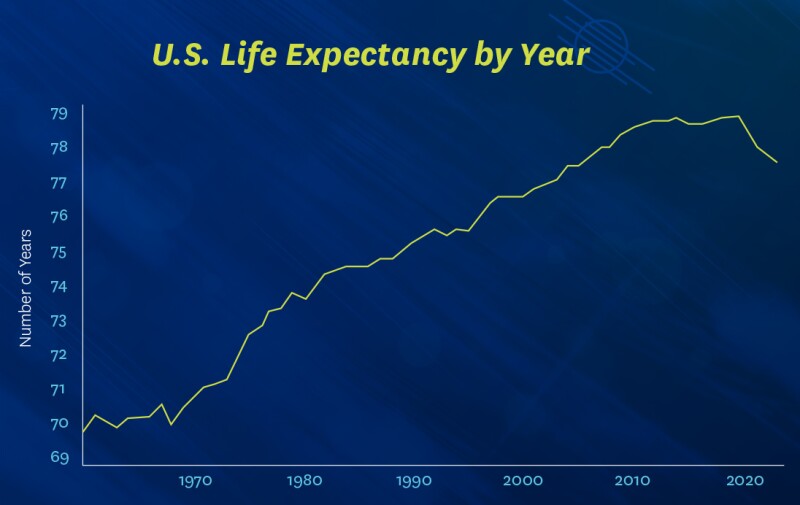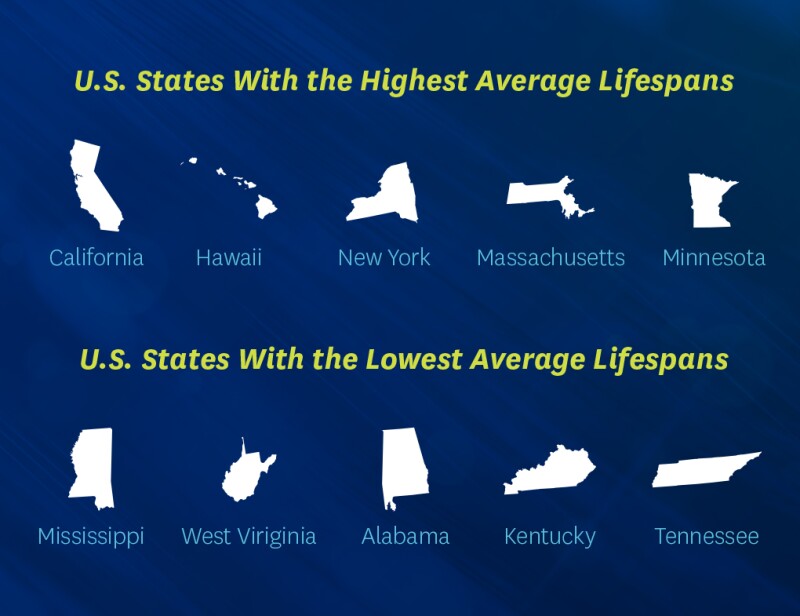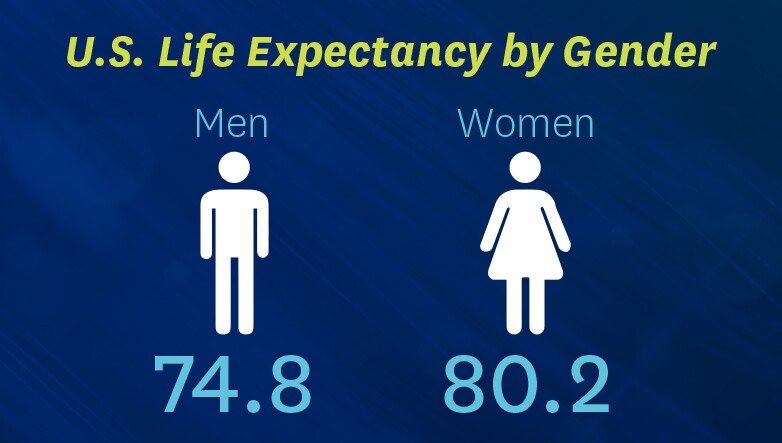In the U.S., life expectancy by year of birth rose steadily and dramatically from the beginning of the 20th century until recently. With only a few notable drops, the expected age of death among Americans climbed from around 49 in the year 19011 to an average of about 77 in 2022.2 However, there have recently been concerning declines in life expectancy in the U.S., with the COVID-19 pandemic and the opioid epidemic in the U.S. among the leading causes for the declines.
Let's take a closer look at what affects current life expectancy predictions and what we can do to help extend life for all, now and in the future.
Life Expectancy in the U.S. by Year: The 20th and 21st Centuries
Population statistics show a steady, although uneven, rise in life expectancy in the United States throughout the 20th century, with one notable exception. The confluence of World War I and the 1918 flu pandemic caused a significant plunge. Average U.S. life expectancy at birth in 1915 was 55.1 years and dropped to 47.2 years in 1918 before resuming its upward trend.1

Over the intervening years, there have been scattered periods of flat or negative growth. Life expectancy trends in the U.S. were relatively flat during the 1960s before resuming their upward climb in the 1970s.
Growth is often the result of cumulative improvements in medicine, civic infrastructure and economic growth. Setbacks frequently result from specific developments, including wars and disease outbreaks. The AIDS epidemic slowed the growth rate in the 1990s and the opioid epidemic that surfaced in the mid-2010s contributed to a short-lived downward trend before the curve flattened out again.1
Life expectancy in the United States has recently declined, notably dropping from 79.7 years in 2017 to 76.1 years in 2021.3 This setback is attributable to the profound impacts of the COVID-19 pandemic, along with persistent health risks such as opioid abuse and obesity.
Just before the advent of the pandemic, projections suggested that life expectancy in the U.S. would incrementally climb to 85.6 years by 2060.4 The CDC released provisional data for 2022 in November 2023 showing a rebound to 77.5 years of overall U.S. life expectancy. Time will tell if historical growth patterns persist in spite of recent challenges.5
The Income-Life Expectancy Correlation

Average life expectancy in the U.S. correlates with income. A comparison of median household income and average life expectancy by state illustrates: In 2019, the five states with the highest average lifespan–California, Hawaii, New York, Massachusetts and Minnesota–also had median incomes well above the national median of $69,600. The five states with the lowest average lifespans–Mississippi, West Virginia, Alabama, Kentucky and Tennessee–had median incomes significantly below the national median.6, 7
There are many factors in addition to income that influence lifespan. A 2016 paper posted by the National Library of Medicine notes that individual health behaviors, including smoking, exercise and obesity affect average lifespan and that, “Individuals in the lowest income quartile have more healthful behaviors and live longer in areas with more immigrants, higher home prices, and more college graduates.”8
What’s the Life Expectancy in the U.S. by Gender?
In 2022, U.S. life expectancy at birth showed a significant gender disparity: men had an average life expectancy of 74.8 years, while women could expect to live to 80.2 years. This difference, amounting to 5.4 years, suggests that gender plays a considerable role in longevity.2

This gap in life expectancy between men and women has shown fluctuating trends over time. While narrowing earlier in the 21st century, the disparity expanded to 5.8 years by 2021, influenced increasingly by COVID-19 fatalities and a surge in drug overdoses among men. Historical data indicate that differences in behaviors such as smoking and drinking, risk of injury, and other health-related choices have contributed to this divide.9
U.S. Life Expectancy Compared to Similar Countries
Recent trends highlight a divergence in life expectancy between the U.S. and similarly affluent countries. Although the U.S. previously ranked close to its peers, life expectancy fell from 79.7 years in 2017 to 76.1 years in 2021, marking a notable departure from the otherwise high rankings among developed nations.3, 9
Meanwhile, other wealthy countries in the Organization for Economic Cooperation and Development (OECD) sustained smaller declines in spite of the fact that the U.S. spends significantly more on healthcare per capita.9 Overall estimated life expectancy for 2021 in Japan was 84.5 years, while Korea reports 83.6, Switzerland 83.5 and Spain 83.2 years.10
Regionally, the relationship of U.S. life expectancy to our neighbors north and south mirrors the geographic relationship. Canada, which has also seen decreases for the last few years, is at 81.3 years of overall life expectancy in 2022.11 The latest data for Mexico shows a life expectancy of 75.4 years, as compared the the U.S. figure of 77.5.12
Global Life Expectancies: Trending Upward, With Major Room for Improvement
The falling death rate among women and children has been a leading contributor to rising global life expectancy. This decline can be attributed largely to industrialization, especially in developing nations. Greater production capacity often brings increased ability to meet basic human needs, improved infrastructure, increased social organization and a significantly expanded healthcare system.
In 2021, the average worldwide life expectancy reached 71 years of age,1 but this figure masks some more alarming numbers in specific regions of the globe. In South Africa, for instance, life expectancy is just 62.3 years.10
Still, considering that the average life expectancy of people before the Industrial Revolution was roughly 30 years, this is a stunning achievement in public health.11
Challenges to Increasing Life Expectancy…and Some Solutions
Of course, there still exist numerous challenges when it comes to life expectancy. Sanitation issues in many parts of South America, Africa and Asia enable the rapid outbreak of diseases that are uncommon elsewhere around the globe. HIV also continues to plague countries that lack access to medicine and reproductive education.
It’s not all bad news, though: Antiretroviral therapy (ART) has the power to significantly extend life for HIV sufferers. And as those new medicines become more widely available, we can expect the average life expectancy of those with HIV/AIDS to rise.
Additionally, public health interventions and initiatives can positively impact life expectancy trends. For example, through a combination of better education and research, more attentive pain management, administration of addiction-reversing medications, and careful use of data, the U.S. government is making efforts to combat the opioid epidemic.13
Health Initiatives at Home and Worldwide
Other health initiatives both at home and around the globe show significant promise. For instance, the American Cancer Society is currently driving initiatives to bring cancer awareness, screening and prevention to underserved communities.
The American College of Sports Medicine and the American Medical Association have partnered to form a nonprofit program known as the Exercise is Medicine initiative. This and other similar programs seek to communicate with doctors and medical providers about the role of exercise and wellness so that they may transmit this information to their patients and help them live healthier lives.
The World Health Organization maintains a raft of health initiatives on an ongoing basis, ranging from programs on HIV/AIDS to healthy aging to nutrition. The combination of these programs can, over time, make a significant difference in life expectancy in the U.S. and elsewhere.
Knowledge Is Power: Learn How You Can Help Raise Life Expectancy
Would you like to learn more about life expectancy and what you can do to increase it? Do you want to educate underserved communities about health initiatives, improve the nutrition of young children or combat challenges like the opioid crisis yourself?
Contact the admissions outreach advisors for Kent State University to learn more about how you can do your part with an online Master of Public Health or online Bachelor of Science in Public Health.
- Retrieved on January 8, 2024, from ourworldindata.org/life-expectancy
- Retrieved on January 8, 2024, from cdc.gov/nchs/data/vsrr/vsrr031.pdf
- Retrieved on January 8, 2024, from cdc.gov/nchs/data/vsrr/vsrr023.pdf
- Retrieved on May 25, 2018, from census.gov/content/dam/Census/library/publications/2020/demo/p25-1145.pdf
- Retrieved on January 8, 2024, from cdc.gov/nchs/pressroom/nchs_press_releases/2023/20231129.htm
- Retrieved on January 8, 2024, from cdc.gov/nchs/pressroom/sosmap/life_expectancy/life_expectancy.htm
- Retrieved on January 8, 2024, from nces.ed.gov/programs/digest/d22/tables/dt22_102.30.asp
- Retrieved on January 8, 2024, from ncbi.nlm.nih.gov/pmc/articles/PMC4866586/
- Retrieved on January 8, 2024, from scientificamerican.com/article/why-the-life-expectancy-gap-between-men-and-women-is-growing/
- Retrieved on January 8, 2024, from healthsystemtracker.org/chart-collection/u-s-life-expectancy-compare-countries/
- Retrieved on January 8, 2024, from data.oecd.org/healthstat/life-expectancy-at-birth.htm
- Retrieved on January 8, 2024, from statcan.gc.ca/n1/daily-quotidien/231127/dq231127b-eng.htm
- Retrieved on January 8, 2024, from oecd.org/mexico/health-at-a-glance-Mexico-EN.pdf
- Retrieved on January 8, 2024, from cdc.gov/opioids/basics/epidemic.html#combatting-the-epidemic
